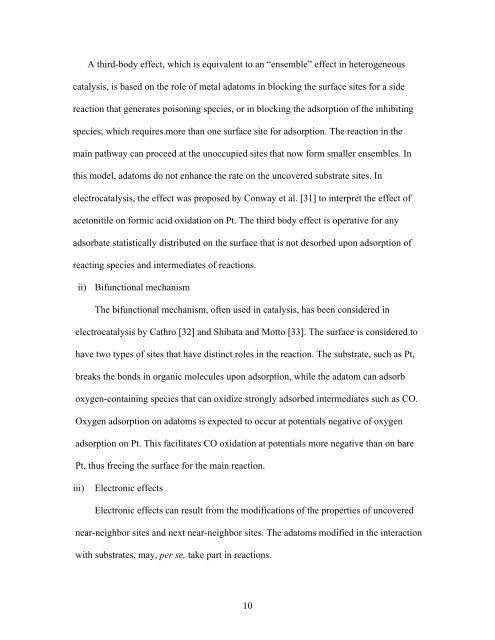electrocatalysis on surfaces modified... - Brookhaven National ...
electrocatalysis on surfaces modified... - Brookhaven National ...
electrocatalysis on surfaces modified... - Brookhaven National ...
Create successful ePaper yourself
Turn your PDF publications into a flip-book with our unique Google optimized e-Paper software.
A third-body effect, which is equivalent to an “ensemble” effect in heterogeneous<br />
catalysis, is based <strong>on</strong> the role of metal adatoms in blocking the surface sites for a side<br />
reacti<strong>on</strong> that generates pois<strong>on</strong>ing species, or in blocking the adsorpti<strong>on</strong> of the inhibiting<br />
species, which requires more than <strong>on</strong>e surface site for adsorpti<strong>on</strong>. The reacti<strong>on</strong> in the<br />
main pathway can proceed at the unoccupied sites that now form smaller ensembles. In<br />
this model, adatoms do not enhance the rate <strong>on</strong> the uncovered substrate sites. In<br />
<str<strong>on</strong>g>electrocatalysis</str<strong>on</strong>g>, the effect was proposed by C<strong>on</strong>way et al. [31] to interpret the effect of<br />
acet<strong>on</strong>itile <strong>on</strong> formic acid oxidati<strong>on</strong> <strong>on</strong> Pt. The third body effect is operative for any<br />
adsorbate statistically distributed <strong>on</strong> the surface that is not desorbed up<strong>on</strong> adsorpti<strong>on</strong> of<br />
reacting species and intermediates of reacti<strong>on</strong>s.<br />
ii)<br />
Bifuncti<strong>on</strong>al mechanism<br />
The bifuncti<strong>on</strong>al mechanism, often used in catalysis, has been c<strong>on</strong>sidered in<br />
<str<strong>on</strong>g>electrocatalysis</str<strong>on</strong>g> by Cathro [32] and Shibata and Motto [33]. The surface is c<strong>on</strong>sidered to<br />
have two types of sites that have distinct roles in the reacti<strong>on</strong>. The substrate, such as Pt,<br />
breaks the b<strong>on</strong>ds in organic molecules up<strong>on</strong> adsorpti<strong>on</strong>, while the adatom can adsorb<br />
oxygen-c<strong>on</strong>taining species that can oxidize str<strong>on</strong>gly adsorbed intermediates such as CO.<br />
Oxygen adsorpti<strong>on</strong> <strong>on</strong> adatoms is expected to occur at potentials negative of oxygen<br />
adsorpti<strong>on</strong> <strong>on</strong> Pt. This facilitates CO oxidati<strong>on</strong> at potentials more negative than <strong>on</strong> bare<br />
Pt, thus freeing the surface for the main reacti<strong>on</strong>.<br />
iii)<br />
Electr<strong>on</strong>ic effects<br />
Electr<strong>on</strong>ic effects can result from the modificati<strong>on</strong>s of the properties of uncovered<br />
near-neighbor sites and next near-neighbor sites. The adatoms <strong>modified</strong> in the interacti<strong>on</strong><br />
with substrates, may, per se, take part in reacti<strong>on</strong>s.<br />
10
















